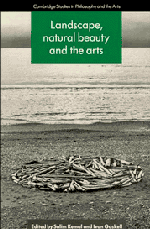Book contents
- Frontmatter
- Contents
- List of contributors
- Editors' acknowledgments
- 1 Nature, fine arts, and aesthetics
- 2 Natural beauty without metaphysics
- 3 Trivial and serious in aesthetic appreciation of nature
- 4 The public prospect and the private view: the politics of taste in eighteenth-century Britain
- 5 Landscape in the cinema: the rhythms of the world and the camera
- 6 The touch of landscape
- 7 Desert and ice: ambivalent aesthetics
- 8 Gardens, earthworks, and environmental art
- 9 Comparing natural and artistic beauty
- 10 Appreciating art and appreciating nature
- 11 The aesthetics of art and nature
- 12 On being moved by nature: between religion and natural history
- Index
1 - Nature, fine arts, and aesthetics
Published online by Cambridge University Press: 03 May 2011
- Frontmatter
- Contents
- List of contributors
- Editors' acknowledgments
- 1 Nature, fine arts, and aesthetics
- 2 Natural beauty without metaphysics
- 3 Trivial and serious in aesthetic appreciation of nature
- 4 The public prospect and the private view: the politics of taste in eighteenth-century Britain
- 5 Landscape in the cinema: the rhythms of the world and the camera
- 6 The touch of landscape
- 7 Desert and ice: ambivalent aesthetics
- 8 Gardens, earthworks, and environmental art
- 9 Comparing natural and artistic beauty
- 10 Appreciating art and appreciating nature
- 11 The aesthetics of art and nature
- 12 On being moved by nature: between religion and natural history
- Index
Summary
Our starting point is Lindisfarne, or Holy Island.
The island is off the coast of Northumbria and connects to the mainland by a causeway that floods at high tide. Much of its early history is known only through Bede's Historia Ecclesiastica Gentis Anglorum. In 635 King Oswald granted the island to Bishop Aidan to found a monastery. A cult grew around the king following his death in battle against the heathen Mercians in 642. Bede writes that people began to collect dust from where the king had fallen with which to cure sicknesses in themselves and their stock.
About this time, another man, who was of the British nation, is said to have been crossing the place where this battle had been fought; and seeing that one spot was more green and more beautiful than the rest of the field, he came to the wise conclusion that there could be no other explanation for this exceptional greenness than that some person of greater sanctity than anyone else in the army had been killed there. So he took away some of that earth wrapped up in a linen cloth…
The Briton found that piece of earth valuable because the color and beauty he saw signified something more. The depth of color and quality of that patch of grass had moral magnitude because the earth, nature, and its workings were affects of divinity.
- Type
- Chapter
- Information
- Landscape, Natural Beauty and the Arts , pp. 1 - 42Publisher: Cambridge University PressPrint publication year: 1993
- 3
- Cited by



